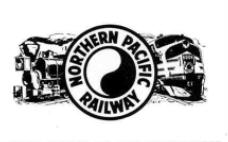Construction of the Main Line
In June, 1870, a contract was made for construction of the Minnesota Division of the road, and work began in July. However, the groundbreaking ceremony, which signalized the launching of the first of the northern transcontinental railroads, took place on February 15 of that year, near the present town of Carlton, Minnesota, which is a few miles west of Duluth. People of Duluth and Superior were informed of the impending ceremony by Ira Spalding, the engineer in charge of construction. A very considerable number drove to the scene in sleighs,
in order to be present. J. B. Culver of Minnesota and Hiram Hays of Wisconsin were appointed to fill and deliver the first wheelbarrow of earth handled in the construction work, and this they did amid cheers of those present. It was for this construction work that the Minnetonka, the first locomotive of the Northern Pacific, was purchased on July 18,1870. From this small but significant beginning, the work of construction proceeded ever westward across rivers, Northern Pacific's first locomotive, over the plains and mountains, and through the wilderness of the West.
At the same time that these historic events were taking place near Duluth similar work was undertaken on the Pacific Coast. It was intended that the- Northern Pacific not only should build westward over the Cascade Mountains in Washington to Puget Sound, but also between Pugct Sound and Portland on the Columbia River. Surveys of the line between Portland, Oregon, and Tacoma, Washington, were made during the summer of 1868 and the spring of 1869. The line between Portland and Tacomn was built in two sections. The first, from Kalama, a convenient point on the north bank of the Columbia River, to Tacoma, was commenced in 1870, and completed in 1873. Much of the material and equipment for the construction of this first standard-gauge railroad in the State of Washington was carried by boats from Atlantic seaports around Cape Horn. Construction started on the line from Tacoma to Seattle in November, 1882; and operation began on July 6, 1884.
The second section of the Pacific Coast line, extending from Goble, on the south bank of the Columbia River opposite Kalama, to Portland, was commenced in May, 1883; and completed in September of that year, the cars being handled between Kalama and Goble by a large car ferry.
While the first section of the Pacific Coast construction was going forward, work continued from the East, and, by 1873, track had been completed as far west as Bismarck, North Dakota, and the Missouri River. In the meantime, on May 1, 1872 the company leased the Lake Superior & Mississippi River Railroad, which owned and operated a line from Duluth to St. Paul. Years later, this line was acquired by purchase.
In 1877, the Northern Pacific completed construction of the line from Brainerd to Sauk Rapids, Minnesota, and made an agreement with the St. Paul & Pacific Railroad Company to u.se its line from Sauk Rapids to Minneapolis and St. Paul. In 1883, the Northern Pacific bought half of the right-of-way from St. Paul & Pacific, from Sauk Rapids to Minneapolis and St. Paul, and built its own line paralleling the St. Paul & Pacific.
To return now to the construction of the Northern Pacific, it is necessary to go back to 1873, because that was the year of the Groat Panic, resulting in the failure of Jay Cooke & Company and the bankruptcy of the railroad. Construction work practically ceased for five years, until further financing could be arranged. Under the presidency of Frederick Billings, for whom the Montana city is named, the westward march of the construction crews was resumed. The eastern boundary of Montana was reached in 1881, and the railhead was at Glendive on July 5th of that year.

During this construction period the Company was faced with acute shortages of both labor and material. The shortage of labor was solved by importing from China 15,000 of the required 25,000 laborers. Shortage of steel required the importa- tion of rails, tie plates, and spikes from France and England.
Construction up the Yellowstone Valley from Glendive proceeded rapidly during 1882, and Livingslon was reached in November of that year, where work halted for the Winter.
Meantime, taking advantage of the completion of the trackage of the Oregon Railroad & Navigation Company between Portland, Oregon and Wallula, in southeastern Washington, construction of the Northern Pacific from this latter point to the east proceeded rapidly, and by the spring of 1883 only three hundred miles remained to be built to complete the line. This last section of the road was most difficult. Much of the work to be done was in the mountains. It included the Boze-man and Mullan tunnels.
Under the presidency of one of the most colorful figures in American history, Henry Villard, the last rails were laid and the last spikeŚnot a golden spikeŚwas driven near a spot already made famous in Montana history.
Home
Back 
Continue
